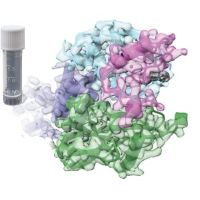Specification
| Description | Recombinant protein from the full-length sequence of Homo sapiens denticleless E3 ubiquitin protein ligase homolog (DTL), transcript variant 1 (NM_016448). |
| Organism | Homo sapiens (Human) |
| Expression Host | Human Cells |
| Tag Info | His or DYKDDDDK. Please contact us if you need further information or require specific designed tag. |
| Purity | Greater than 90% by SDS-PAGE gel |
| Uniprot ID | Q9NZJ0 |
| Entry Name | DTL_HUMAN |
| Gene Names | DTL CDT2 CDW1 DCAF2 L2DTL RAMP |
| Alternative Gene Names | CDT2 CDW1 DCAF2 L2DTL RAMP |
| Alternative Protein Names | Denticleless protein homolog (DDB1- and CUL4-associated factor 2) (Lethal(2) denticleless protein homolog) (Retinoic acid-regulated nuclear matrix-associated protein) |
| Application | Antigens, Western, ELISA and other in vitro binding or in vivo functional assays, and protein-protein interaction studies; For research & development use only! |
| Buffer | Purified protein formulated in a sterile solution of PBS buffer, pH7.2, without any preservatives |
| Endotoxin | Endotoxin level is < 0.1 ng/µg of protein (<1EU /µg) |
| Length | 730 |
| Molecular Weight(Da) | 79468 |
| Protein Sequence | (The sequence of expressed protein may have some variation from the sequence shown below. Please contact us for the exact sequence.) MLFNSVLRQPQLGVLRNGWSSQYPLQSLLTGYQCSGNDEHTSYGETGVPVPPFGCTFSSAPNMEHVLAVANEEGFVRLYNTESQSFRKKCFKEWMAHWNAVFDLAWVPGELKLVTAAGDQTAKFWDVKAGELIGTCKGHQCSLKSVAFSKFEKAVFCTGGRDGNIMVWDTRCNKKDGFYRQVNQISGAHNTSDKQTPSKPKKKQNSKGLAPSVDFQQSVTVVLFQDENTLVSAGAVDGIIKVWDLRKNYTAYRQEPIASKSFLYPGSSTRKLGYSSLILDSTGSTLFANCTDDNIYMFNMTGLKTSPVAIFNGHQNSTFYVKSSLSPDDQFLVSGSSDEAAYIWKVSTPWQPPTVLLGHSQEVTSVCWCPSDFTKIATCSDDNTLKIWRLNRGLEEKPGGDKLSTVGWASQKKKESRPGLVTVTSSQSTPAKAPRAKCNPSNSSPSSAACAPSCAGDLPLPSNTPTFSIKTSPAKARSPINRRGSVSSVSPKPPSSFKMSIRNWVTRTPSSSPPITPPASETKIMSPRKALIPVSQKSSQAEACSESRNRVKRRLDSSCLESVKQKCVKSCNCVTELDGQVENLHLDLCCLAGNQEDLSKDSLGPTKSSKIEGAGTSISEPPSPISPYASESCGTLPLPLRPCGEGSEMVGKENSSPENKNWLLAMAAKRKAENPSPRSPSSQTPNSRRQSGKKLPSPVTITPSSMRKICTYFHRKSQEDFCGPEHSTEL |
Background
| Function | FUNCTION: Substrate-specific adapter of a DCX (DDB1-CUL4-X-box) E3 ubiquitin-protein ligase complex required for cell cycle control, DNA damage response and translesion DNA synthesis. The DCX(DTL) complex, also named CRL4(CDT2) complex, mediates the polyubiquitination and subsequent degradation of CDT1, CDKN1A/p21(CIP1), FBH1, KMT5A and SDE2 (PubMed:16861906, PubMed:16949367, PubMed:16964240, PubMed:17085480, PubMed:18703516, PubMed:18794347, PubMed:18794348, PubMed:19332548, PubMed:20129063, PubMed:23478441, PubMed:23478445, PubMed:23677613, PubMed:27906959). CDT1 degradation in response to DNA damage is necessary to ensure proper cell cycle regulation of DNA replication (PubMed:16861906, PubMed:16949367, PubMed:17085480). CDKN1A/p21(CIP1) degradation during S phase or following UV irradiation is essential to control replication licensing (PubMed:18794348, PubMed:19332548). KMT5A degradation is also important for a proper regulation of mechanisms such as TGF-beta signaling, cell cycle progression, DNA repair and cell migration (PubMed:23478445). Most substrates require their interaction with PCNA for their polyubiquitination: substrates interact with PCNA via their PIP-box, and those containing the 'K+4' motif in the PIP box, recruit the DCX(DTL) complex, leading to their degradation. In undamaged proliferating cells, the DCX(DTL) complex also promotes the 'Lys-164' monoubiquitination of PCNA, thereby being involved in PCNA-dependent translesion DNA synthesis (PubMed:20129063, PubMed:23478441, PubMed:23478445, PubMed:23677613). The DDB1-CUL4A-DTL E3 ligase complex regulates the circadian clock function by mediating the ubiquitination and degradation of CRY1 (PubMed:26431207). {ECO:0000269|PubMed:16861906, ECO:0000269|PubMed:16949367, ECO:0000269|PubMed:16964240, ECO:0000269|PubMed:17085480, ECO:0000269|PubMed:18703516, ECO:0000269|PubMed:18794347, ECO:0000269|PubMed:18794348, ECO:0000269|PubMed:19332548, ECO:0000269|PubMed:20129063, ECO:0000269|PubMed:23478441, ECO:0000269|PubMed:23478445, ECO:0000269|PubMed:23677613, ECO:0000269|PubMed:26431207, ECO:0000269|PubMed:27906959}. |
| Pathway | Protein modification; protein ubiquitination. |
| Protein Families | WD repeat cdt2 family |
| Tissue Specificity | Expressed in placenta and testis, very low expression seen in skeletal muscle. Detected in all hematopoietic tissues examined, with highest expression in thymus and bone marrow. A low level detected in the spleen and lymph node, and barely detectable level in the peripheral leukocytes. RA treatment down-regulated the expression in NT2 cell. {ECO:0000269|PubMed:11278750, ECO:0000269|PubMed:17106265}. |
QC Data
| Note | Please contact us for QC Data |
| Product Image (Reference Only) |  |

